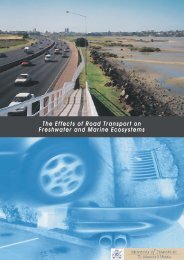Motor Vehicle Crashes in New Zealand 2011 - Ministry of Transport
Motor Vehicle Crashes in New Zealand 2011 - Ministry of Transport
Motor Vehicle Crashes in New Zealand 2011 - Ministry of Transport
You also want an ePaper? Increase the reach of your titles
YUMPU automatically turns print PDFs into web optimized ePapers that Google loves.
10<br />
<strong>Motor</strong> <strong>Vehicle</strong> <strong>Crashes</strong> <strong>in</strong> <strong>New</strong> <strong>Zealand</strong> <strong>2011</strong><br />
Introduction and Notes<br />
Introduction<br />
This statistical statement conta<strong>in</strong>s tabulations <strong>of</strong> <strong>in</strong>formation<br />
coded from Traffic Crash Reports. To put these data <strong>in</strong>to<br />
context, the follow<strong>in</strong>g is a brief description <strong>of</strong> the process<br />
which has resulted <strong>in</strong> this publication.<br />
When a road traffic crash <strong>in</strong>volves a motor vehicle and<br />
results <strong>in</strong> someone be<strong>in</strong>g <strong>in</strong>jured, the law requires<br />
that crash to be reported. However, comprehensive<br />
hospital-based surveys <strong>in</strong>dicate that only about two thirds<br />
<strong>of</strong> such <strong>in</strong>jury crashes are reported to the <strong>New</strong> <strong>Zealand</strong><br />
<strong>Transport</strong> Agency (NZTA). There may also be a report<strong>in</strong>g<br />
bias by type <strong>of</strong> road user and by day <strong>of</strong> week and by hour <strong>of</strong><br />
day and by region.<br />
When an <strong>in</strong>jury crash is reported it is attended usually by<br />
a police <strong>of</strong>ficer. The report<strong>in</strong>g <strong>of</strong>ficer’s primary duties are<br />
to prevent further <strong>in</strong>jury and to help those <strong>in</strong>jured. The next<br />
duty is a legal one, to ascerta<strong>in</strong> whether anyone <strong>in</strong>volved <strong>in</strong><br />
the crash has committed an <strong>of</strong>fence.<br />
After deal<strong>in</strong>g with other duties, this <strong>of</strong>ficer completes a<br />
Traffic Crash Report (TCR). The TCR is exam<strong>in</strong>ed and<br />
coded by traffic eng<strong>in</strong>eers and by NZTA adm<strong>in</strong>istrative staff.<br />
This coded <strong>in</strong>formation is then entered <strong>in</strong>to the Crash<br />
Analysis System (CAS). After edit<strong>in</strong>g and check<strong>in</strong>g, the<br />
statistical statement is published.<br />
NOTES<br />
1. Under section 22(3) <strong>of</strong> the Land <strong>Transport</strong> Act 1998 a<br />
driver <strong>in</strong>volved <strong>in</strong> an accident result<strong>in</strong>g <strong>in</strong> death or <strong>in</strong>jury<br />
to any person .... must report the accident <strong>in</strong> person ...<br />
as soon as reasonably practicable, and <strong>in</strong> any case not<br />
later than 24 hours after the time <strong>of</strong> the accident.<br />
2. Dur<strong>in</strong>g the years 1975 to 1979 a system <strong>of</strong> crash<br />
report<strong>in</strong>g was used where a prelim<strong>in</strong>ary report,<br />
conta<strong>in</strong><strong>in</strong>g partial details <strong>of</strong> each crash, was sent to the<br />
M<strong>in</strong>istry <strong>of</strong> <strong>Transport</strong> with<strong>in</strong> 24 hours <strong>of</strong> the crash or <strong>of</strong> it<br />
be<strong>in</strong>g reported. After <strong>in</strong>vestigations were completed a<br />
f<strong>in</strong>al report was supplied. By the time <strong>of</strong> pr<strong>in</strong>t<strong>in</strong>g,<br />
prelim<strong>in</strong>ary reports only had been received for a number<br />
<strong>of</strong> crashes. Details <strong>of</strong> those crashes were <strong>in</strong>complete<br />
and appeared as ‘unknown’ <strong>in</strong> the tables. From 1980 the<br />
system returned to one report only and as a<br />
consequence the number <strong>of</strong> ‘unknowns’ has reduced.<br />
The follow<strong>in</strong>g notes give brief explanations <strong>of</strong> terms used<br />
<strong>in</strong> the tables.<br />
3. <strong>Motor</strong> vehicle crash: Any crash that occurs on a public<br />
road that is attributable directly or <strong>in</strong>directly to a motor<br />
vehicle or its load. <strong>Crashes</strong> which do not occur on public<br />
roads are excluded, for example tractor crashes on<br />
farms. The data <strong>in</strong> this statistical statement <strong>in</strong>cludes only<br />
crashes that <strong>in</strong>volve a motor vehicle. A crash between a<br />
cyclist and a pedestrian, for example, would not be<br />
<strong>in</strong>cluded.<br />
4. Fatal <strong>in</strong>juries: Up to and <strong>in</strong>clud<strong>in</strong>g 1974, comprised<br />
<strong>in</strong>juries that resulted <strong>in</strong> death with<strong>in</strong> 28 days <strong>of</strong> the<br />
crash. From, and <strong>in</strong>clud<strong>in</strong>g, 1975 they comprise <strong>in</strong>juries<br />
that result <strong>in</strong> death with<strong>in</strong> 30 days <strong>of</strong> the crash. This is<br />
consistent with the <strong>in</strong>ternational def<strong>in</strong>ition.<br />
Exclusions: There are a number <strong>of</strong> cases where road<br />
deaths or motor vehicle deaths are not <strong>in</strong>cluded <strong>in</strong> the<br />
<strong>of</strong>ficial road toll. They <strong>in</strong>clude:<br />
> deaths that do not occur on a public road or a road<br />
to which the public has access (eg race track or farm<br />
paddock)<br />
> deaths that did not result from <strong>in</strong>juries susta<strong>in</strong>ed<br />
<strong>in</strong> the crash (eg when the coroner determ<strong>in</strong>es that a<br />
driver died from a heart attack)<br />
> suicide or murder<br />
> deaths on the road where a motor vehicle was not<br />
<strong>in</strong>volved (eg cyclist only crash)<br />
These def<strong>in</strong>itions are <strong>in</strong> l<strong>in</strong>e with the most common<br />
<strong>in</strong>ternational def<strong>in</strong>itions. Although these deaths are<br />
excluded from the <strong>of</strong>ficial road toll, a record is kept <strong>of</strong><br />
the crash details.<br />
5. Serious <strong>in</strong>juries: Fractures, concussion, <strong>in</strong>ternal <strong>in</strong>juries,<br />
crush<strong>in</strong>gs, severe cuts and lacerations, severe general<br />
shock necessitat<strong>in</strong>g medical treatment, and any other<br />
<strong>in</strong>jury <strong>in</strong>volv<strong>in</strong>g removal to and detention <strong>in</strong> hospital.<br />
6. M<strong>in</strong>or <strong>in</strong>juries: Injuries <strong>of</strong> a m<strong>in</strong>or nature such as spra<strong>in</strong>s<br />
and bruises.<br />
7. Crash, casualty, vehicles <strong>in</strong>volved: These terms <strong>of</strong>ten<br />
cause some confusion. The follow<strong>in</strong>g example may help<br />
to clarify their use. If two motor vehicles collide, one<br />
motor vehicle crash has taken place. If four people <strong>in</strong><br />
one <strong>of</strong> the vehicles were <strong>in</strong>jured and two <strong>in</strong> the other,<br />
then this one crash resulted <strong>in</strong> six casualties. The<br />
number <strong>of</strong> vehicles <strong>in</strong>volved was two.

















